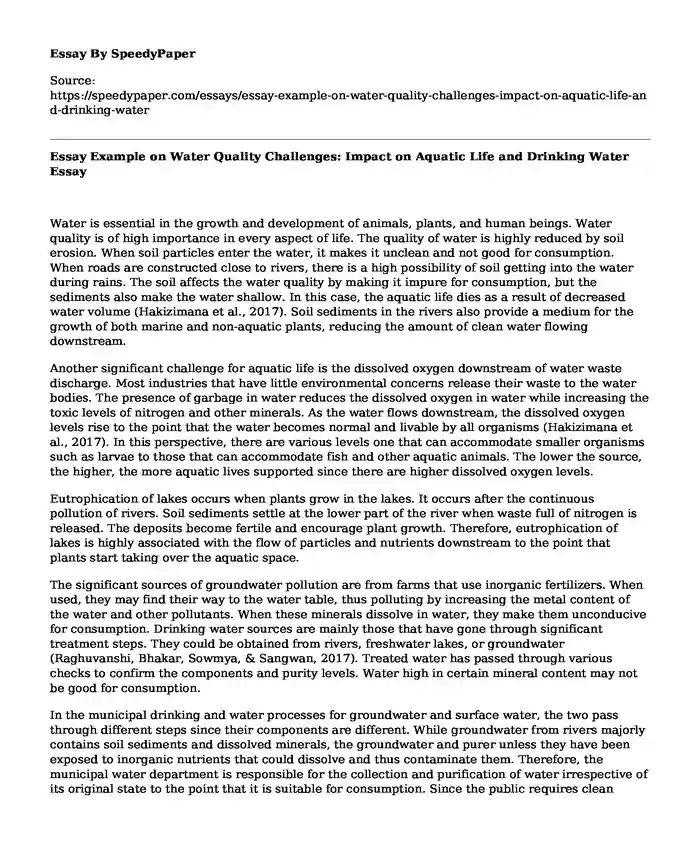Water is essential in the growth and development of animals, plants, and human beings. Water quality is of high importance in every aspect of life. The quality of water is highly reduced by soil erosion. When soil particles enter the water, it makes it unclean and not good for consumption. When roads are constructed close to rivers, there is a high possibility of soil getting into the water during rains. The soil affects the water quality by making it impure for consumption, but the sediments also make the water shallow. In this case, the aquatic life dies as a result of decreased water volume (Hakizimana et al., 2017). Soil sediments in the rivers also provide a medium for the growth of both marine and non-aquatic plants, reducing the amount of clean water flowing downstream.
Another significant challenge for aquatic life is the dissolved oxygen downstream of water waste discharge. Most industries that have little environmental concerns release their waste to the water bodies. The presence of garbage in water reduces the dissolved oxygen in water while increasing the toxic levels of nitrogen and other minerals. As the water flows downstream, the dissolved oxygen levels rise to the point that the water becomes normal and livable by all organisms (Hakizimana et al., 2017). In this perspective, there are various levels one that can accommodate smaller organisms such as larvae to those that can accommodate fish and other aquatic animals. The lower the source, the higher, the more aquatic lives supported since there are higher dissolved oxygen levels.
Eutrophication of lakes occurs when plants grow in the lakes. It occurs after the continuous pollution of rivers. Soil sediments settle at the lower part of the river when waste full of nitrogen is released. The deposits become fertile and encourage plant growth. Therefore, eutrophication of lakes is highly associated with the flow of particles and nutrients downstream to the point that plants start taking over the aquatic space.
The significant sources of groundwater pollution are from farms that use inorganic fertilizers. When used, they may find their way to the water table, thus polluting by increasing the metal content of the water and other pollutants. When these minerals dissolve in water, they make them unconducive for consumption. Drinking water sources are mainly those that have gone through significant treatment steps. They could be obtained from rivers, freshwater lakes, or groundwater (Raghuvanshi, Bhakar, Sowmya, & Sangwan, 2017). Treated water has passed through various checks to confirm the components and purity levels. Water high in certain mineral content may not be good for consumption.
In the municipal drinking and water processes for groundwater and surface water, the two pass through different steps since their components are different. While groundwater from rivers majorly contains soil sediments and dissolved minerals, the groundwater and purer unless they have been exposed to inorganic nutrients that could dissolve and thus contaminate them. Therefore, the municipal water department is responsible for the collection and purification of water irrespective of its original state to the point that it is suitable for consumption. Since the public requires clean drinking water, both groundwater and surface water are used for public consumption (Raghuvanshi, Bhakar, Sowmya, & Sangwan, 2017). Thus, the municipal water treatment ensures that there is clean and ready water for public consumption. The process entails the removal of soil particles, followed by the removal of bad odor and chemicals. The pH is also checked to ensure that it stays at optimum; thus, in the process, if it is detected to be slightly high or low, it has to be checked and controlled to the right amount.
References
Hakizimana, J. N., Gourich, B., Chafi, M., Stiriba, Y., Vial, C., Drogui, P., & Naja, J. (2017). Electrocoagulation process in water treatment: A review of electrocoagulation modeling approaches. Desalination, 404, 1-21.
Raghuvanshi, S., Bhakar, V., Sowmya, C., & Sangwan, K. S. (2017). Wastewater treatment plant life cycle assessment: treatment process to reuse of water. Procedia CIRP, 61, 761-766.
Cite this page
Essay Example on Water Quality Challenges: Impact on Aquatic Life and Drinking Water. (2023, Nov 04). Retrieved from https://speedypaper.com/essays/essay-example-on-water-quality-challenges-impact-on-aquatic-life-and-drinking-water
Request Removal
If you are the original author of this essay and no longer wish to have it published on the SpeedyPaper website, please click below to request its removal:
- Free Essay on Pike River Mine Disaster in New Zealand
- Essay Example about Wabash River
- Free Paper Example on the Deepwater Horizon Oil Spill
- Mr. President,
- Cause of the Exxon Valdez Oil Spill, Free Paper Sample
- Michigan's Relationship Between Climate, Soils, and Forestry. Paper Example
- Paper Example - The fire service department in the United Kingdom
Popular categories





